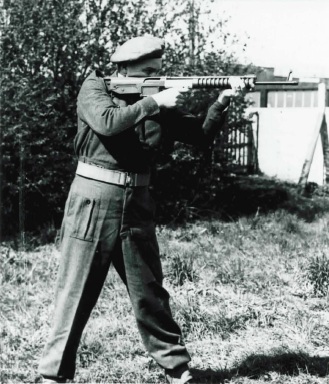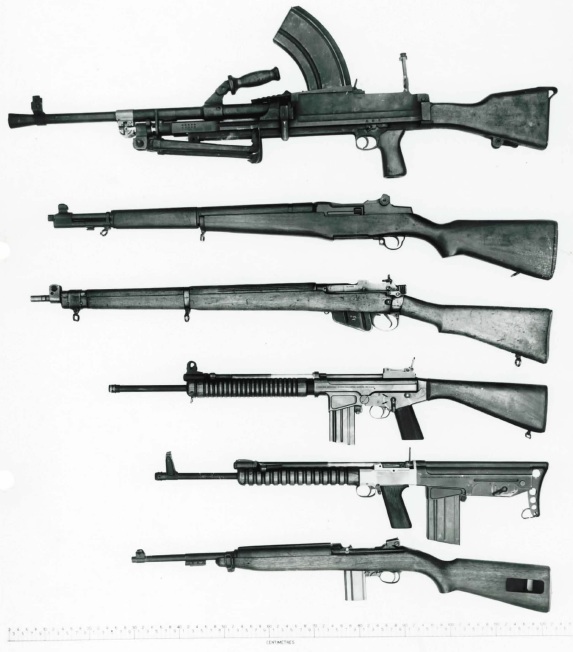The FN FAL was in development very shortly after the conclusion of World War II, during the height of assault rifle fever. Everyone (more or less) was very interested in the concept of the sturmgewehr as put into practice by Germany, and most major militaries were experimenting with similar designs of their own. The British were no exception, and they were looking at the new Belgian rifle (which would become the FAL) chambered in both 7.92×33 and .280 British, and designed in both a traditional and bullpup layout.
If you’ve ever wondered why countries made the transition from full-power heavy cartridges to lighter ones for general use (it has nothing to do with the internet myth of wounding one man to take three out of combat), here it is in a nutshell, as described by FN:
FABRIQUE NATIONALE D’ ARMES DE GUERRE , S . A., Herstal-near-Liege (Belgium), present the particulars of their new infantry weapon which they have designed to fulfil the requirement s of modern infantry. As a result of the experience and knowledge gained on all fronts during the last war, the tactics of modern infantry have undergone some change. It is no longer considered probable that the rifle will be used except at short ranges or that the light machine gun will influence the battle at ranges greater than 600 – 1.000 yards.
In this concept, it i s possible to consider the abolition
of several of the present arms which fire a small arm cartridge and to replace them by a single modern weapon. With this aim in view F.N. have designed thi s new arm embodying many of the characteristics of the machine carbine and the self loading rifle combined with a cartridge which is more accurate and powerful than that of the machine carbine but lighter and shorter than the rifle
cartridge . This combination will give to the infantry one weapon to replace the the machine carbine, magazine rifle and self loading rifle. Fitted with a light bipod, which is easily carried in the pocket, it can act as a light machine gun in firing short bursts with adequate accuracy up to ranges of 600 yards and even longer. A platoon completely armed with this weapon can develop a rate of fire and power greater than that possessed by the present day platoon.The saving in training time, maintenance and production
by having one weapon to replace three or four different types needs no stressing.

It was all about logistics. The concept may not have been entirely successful (light machine guns still play a major role in combat, having not been adequately replaced by assault rifles), but that was the thinking in the 50s.

We have this February 1950 FN report on the FAL available for download, including a number of photos of the prototype rifles:
(1950) Prototype FN FAL manual (English)


Awesome post !!!
.280 British is a great cartridge, unfortunately it wasn’t adopted 🙁
So many great cartridges were forgotten – .280British, .276 Pedersen and many others.
.280 british caliber is better???
I dont think so,Better than german 7,92×57 or 8mm mauser rounds there is no better rounds unless its a high caliber..
Val : it all depends on what you’re trying to achieve. Accurate fire at 1000 yards ?
Then yes, .30-06, .303 or 7,92x57mm would be excellent choices – but way overpowered if the fire-zone is within 200m or so.
The .280-30 was settle upon by us Brits in 1950/51 after exhausive analysis of the two world wars by the Ideal Calibre Committee which sat from 1946-50 or so.
Buy hey ! The .280-30 lives on ! Have a look at the 6.5mm and 6.8mm Grendell
cartridges – arrived at (once again reinventing the wheel) in the USA after much the same evaluation as we did in the immediate post-war years.
Val
Sure, .280 British is much less powerful than 8mm mauser ! But it was designed as an intermediate cartridge…so it’s better than 5.56x45NATO , 7.62×39,7.92x33Kurz (IMHO). It’s .30-06 case shortened to 43mm and necked down to 7mm…and for assault rifles it is DO better !
Better doesn’t always mean stronger!
Excellent post! If only certain die-hard traditionalists hadn’t been able to force the 7.62x51mm on the U.S., and by extension, NATO. We would probably still be using that lighter round, which rounds like the 6.5x39mm and 6.7x43mm were essentially trying to recreate.
I think it would be better to leave the .30-06 as a main MG and sniper round and adopt something like .280British as an assault rifle cartridge. Look what tendency we have now – snipers need stronger .30 cal cartridges (that’s why they try .300WinMag etc.) and everybody are looking for something better than 5.56×45 for AR.
Of course, maybe it’s easy to make such conclusions today than it was in late 1940s.
We 7mm cranks have been trying to get something like this adopted for at least a century. That does seem to be a “sweet spot” for a smokeless cartridge. The Patterrn 14 Enfield was going to have it, the original Garand was going to have it…
what you say regarding LMGs not having been entirely replaced is definitely true, but i think it deserves mention that, magazine fed LMGs have been entirely replaced by belt fed ones. both german ideas, the GPMG, and the assault rifle have been adopted the only difference being the interchangability of ammunition